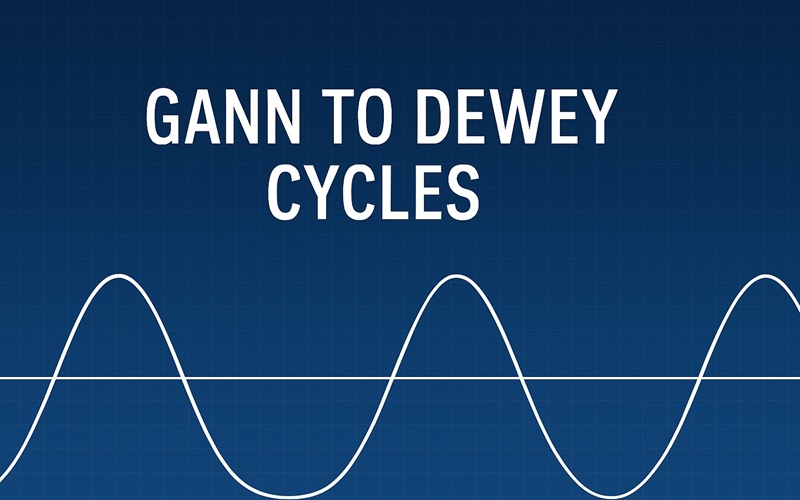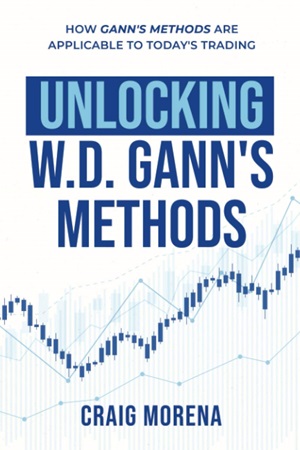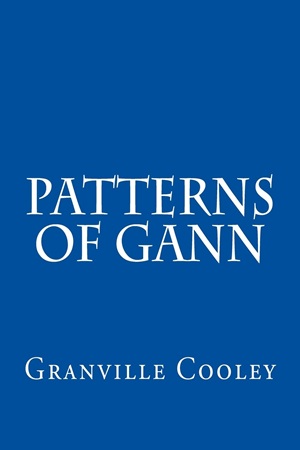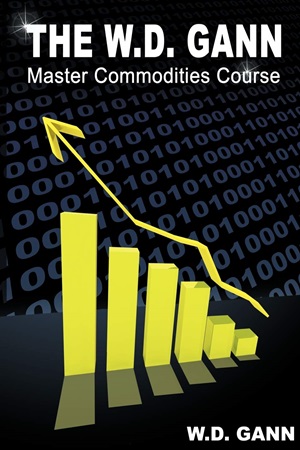Articles
Gann to Dewey Cycle By Jules Newsom

Intro:
GANN TO DEWEY CYCLES by Jules Newsom is a compelling deep dive into the foundational principles and evolution of cycle theory in financial markets. The article compares and connects the insights of two pivotal figures—W.D. Gann and Edward R. Dewey—and explores how their unique approaches to cycle analysis shaped modern financial forecasting.
From Gann’s metaphysical and numerological techniques to Dewey’s scientific and data-driven research for the Foundation for the Study of Cycles, this article bridges historical methods with today’s computer-assisted forecasting tools. It even highlights contributions like Ferrera’s Wheels in Wheels and software-based cycle overlays for modern traders.
Whether you’re a Gann enthusiast, a cycles researcher, or a trader seeking predictive tools for market timing, this article serves as a powerful introduction to cycle forecasting’s sacred and scientific sides.
Description:
How do cycles work? You might as well ask the greater question “how does the universe work?” The real answer is that nobody knows for sure. But, “how to work with cycles” is a different story. And that kind of answer comes from our own point of view, level of experience and definition of the word Cycle itself. From a research standpoint, it makes a good starting point, and as it is written, “if you don’t ask, you won’t receive.” We will briefly look at two men deeply devoted to cycle investigation, W.D. Gann and Edward Dewey.
The basics of Mr. Gann’s life story are more familiar. Details are readily available in many other articles and can be found all over the Internet. For over 50 years, W.D. Gann never stopped studying. Starting around 1900, as approximated from the 1909 Ticker Magazine interview, he also wrote books and courses for over 30 years until his death in 1955.
Mr. Gann said it took 10 years and 20 years of concentrated study to get a deeper understanding about cycles and learn to properly apply them. In the book list he left us, there are 80 books covering many different disciplines and perspectives grouped under the categories of Numerology, Astrological and Scientific-Miscellaneous. Used for preparedness on spiritual, mental, emotional and physical levels, keep in mind that these books are far from a fact finding mission only. In some respects, we do have it a little easier finding some answers. We have a W.D. Gann to follow along with, And, we also have the blessings and curse of the computer.
In regard to Mr. Dewey, in 1931 he was working on why “The Crash of 1929” happened for President Hoover as his Chief Economic Analyst. Dewey was introduced to the idea of cycles by Cheapen Haskins, the Managing Editor of Forbes Magazine. They started a successful financial advisory in March 1937. With a growing interest in cycles, Dewey started the Foundation for the Study of Cycles in 1941. The corporate charter was set up as a “not-for-profit” (how ironic) scientific, educational organization.
Although nothing is officially written that they worked together, no doubt Gann and Dewey would have known of each other. Just to name a few other top analysts of the day, Garfield Drew, Alan Andrews and financial astrologer Cmdr. David Williams were friends of Dewey. In 1959, Dewey tells of meeting with George Marechal. He was even privileged to have seen Marechal’s original worksheets used in making his famous 15 year Dow Jones forecast.
The former Cycles Foundation, Executive Director, Dr. Jeffrey Horovitz (1986-1989) was asked if W.D. Gann made any editorial or financial contributions to the Foundation, he said “he was not aware of any.” From a 1982 cassette tape, John Gann (son of W.D.) tells an interesting story about Dewey. John was talking about long term Interest Rate cycles, as the guest speaker at a meeting for some Society of market analysts.
“In 1947, Edward R. Dewey and Edwin F. Dakin wrote “Cycles: The Science of Prediction.” A book signing was to be sponsored by a group of securities analysts. John recalls “I have never seen such a Fantastic response like this for a book in the financial community.” It had created such a stir that the room was jam packed and people were standing out in the streets. Everyone there and in the industry wanted to know more about cycles.”
From the start, Dewey gathered the best established scientific methods for analyzing cycles. In general, for any chart of data investigated, stock markets, natural phenomena, etc., determine the components that made the chart look the way it does. Once a good fit is found, it can be projected into the future.
📖 Learn Gann’s Techniques – Suggested Reads
In 1944, Dewey made his first official stock market forecast using 10 to 11 cycles. It looked good for about 10 years. Later on, 30 to 50 different cycles were used for market forecasts. He was always looking for newer analytical procedures to find and validate cyclic behavior. Finally in 1955, Dewey put together “How to Make a Cycle Analysis.” Over 600 pages, it is the most thorough and unique collection of workable cycle techniques, articles, research and ideas compiled over 20 years. This includes the Foundation’s correspondence course on Cycle Analysis, Trend analysis, Ratio Charts, Chapin Hoskins Time Charts, Periodic Tables, Harmonic Analysis etc. It is THE Cycle Sourcebook.
Based on the methods chosen to uncover how cycles work, both Gann and Dewey had different views on the definitions. The Cycle Foundation shares the more commonly used idea of a schedule or sequence of regularly spaced extreme priced turning points. Gann’s view of cycles referenced that certain types of markets (defined by their actions) repeated. For example, a 10 year cycle has patterns and situations going to recur now as it did 10 years ago.
To bring a combined analysis of those definitions up to the current time, we have the added benefit of computer aided tools. Here are 2 useful computer programs. In the book “Wheels in Wheels – the Art of Forecasting Financial Markets ” by Daniel T. Ferrera, the techniques are applied to present day markets. Focusing on the Dow Jones Averages, the cyclic components are thoroughly examined and projected 100 years into the future. There is also analysis on Gold and Interest Rates. Rare articles on other cycle finding related concepts add more value to this book.
On the accompanying CD are many Excel spreadsheet programs including those that make it easy to create cycle composites. These can then be overlaid on actual market price data for verification of a good cyclic match. Turning points can be projected into the future as far as you want.
To give another layer of insight to cycle analysis as a useful tool, with the help of computers, several aspects of the cycle summation process or Wave Mechanics can be made interactive and dynamic with one key stroke. The following notes describe some interesting capabilities from a simple program called CycleKT.
After the cycle-composite wavy line is made from user defined cycles, it can be changed into a true High/Low bar chart. Treating each bar as a day, you can group them into any size you want, such as weekly or monthly, just like penciling in weekly or monthly boxes on actual paper charts. These can be slid back and forth to show how smaller cycles appear in bars of larger time frames.
By sliding (change the phasing) any of the individual cycles forward or back-wards you can see how the whole market picture changes. For example, when combining 10, 20 and 40 bar cycles, in a topping or bottoming phase, the distance between the major lows will rarely be 40 bars apart as might be expected. They can actually be anywhere less than 30 to over 50 bars apart, depending where each cycle starts. That could adversely affect your analysis if you didn’t know it was possible.
On top of this, Moving averages, Hurst Channels, and sliding Momentum indicators, can also be displayed. These formulas are the basis of most technical analysis tools today. Seeing how their appearances change, even within the same set of cycles, can have an effect on trading strategies.
All of these functions help train the eyes to see charts from slightly different perspectives. These in turn might offer extra confirmations to our analytical or trading decisions. It all comes down to how we correctly interpret a chart depends on our own insights as to what forces we think went into it to make it look that way. These variations of cyclic analysis are just some of the ways to consider.
Mathematical techniques, later to be used as proofs, are learned from books. For specific applications such as related to markets, these tools must be blended together with our own research. To find more articles on cycle analysis, including a great one on Wave Mechanics, check out the Sacred Science Institute.
The books and software programs mentioned above can be found at Sacred Science Institute. They are also available in the Traders World book section of this magazine. The Sacret Science Institute carries on the tradition of Donald Mack and Dr. Jerry Baumring from the days of the Investment Centre over 20 years ago, Sacred Science Institute maintains the most comprehensive insightful collection of books including most of the those available from Gann’s recommended book list. Their high quality reproductions (in color when applicable) include rare volumes for understanding the universal principles, ancient wisdom, cosmology, the complete trading courses of Gann and other market Masters and their connection to the physical and metaphysical laws, which they studied, copied and alluded to.




